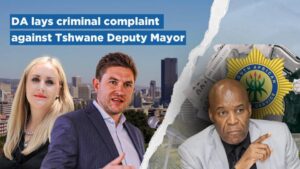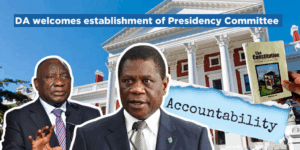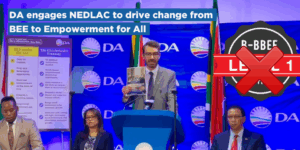Speech by Solly Msimanga Executive Mayor of Tshwane
It is indeed a great honor and privilege for me to share this day with all gathered here to be part of this very important event – the opening of the Heuweloord Emergency Services Station, the handing over of the 18 Rapid Intervention Vehicles and the new ambulances for the City of Tshwane Emergency Services. Today’s event is also to showcase the human spirit as we recognize the dedicated men and women in uniform who have served the department and the City over many years, ranging from 30 to 40 years. This is a great milestone to achieve.
In our 2016 election manifesto we have committed to improve Law enforcement by assessing the fitness of law enforcement and emergency personnel on a regular basis to ensure that they are well prepared to enforce and protect residents including saving their lives. Today’s gathering illustrates our commitment to the people of Tshwane that we care about their wellbeing.
I also take this opportunity to pledge that we will bring these improved services to every region in the Metro and we asked for your patience in this regard. We thank you for your cooperation thus far and recommit that, even though it may take some time, ushintsho luyeza!
When there is an emergency, be it medical or fire related, our people’s most basic concern is whether the help will show up when needed, in time to save their lives.
As the Capital City of our Rainbow Nation, we do not only house the seat of Government and other State Departments, we host the most embassies and foreign missions than in any other metro. Notwithstanding having the most academic institutions, the automotive industry, the Council of Scientific Industrial Research and the South Africa Bureau of Standards, also form an integral part of the City. The state of emergency services across the city should be fully capacitated and demonstrate that we are a Capital City of the one of the biggest economies on the African continent.
In capacitating the Emergency Service fleet, the City purchased 18 Rapid Intervention Vehicles, 33 Ambulances and 1 Maxilance demonstrating our determination to bring Emergency Services, a part of service delivery, to our communities. These vehicles have different capabilities needed for our safety and to save lives. The Rapid Intervention Vehicles:
- Are smaller and will improve budgetary savings,
- Carry 350 litres of water, delivered from an ultra-high valve pressure,
- Manufactured on a 4.5lt V8 diesel engine, have an upgraded suspension and brakes to endure our conditions
- Are fitted with TNT Hydraulic Rescue equipment, known as the Jaws of Life that carry a lifetime warranty, a hydraulic cutter and a hydraulic spreader with a spreading force of 28 tons.
We believe its local action will go a long way towards the creation and the building of safe and sustainable communities. As previously alluded to, the new Emergency Services Station will not only serve the community of Heuweloord, Olievenhoutbosch, Laezonia, Sunderlandridge, Mooiplaats, Laudium, Claudius, Erasmia and Wierdapark but will also respond to motor vehicle accidents on the R55 and the N14 – Pretoria/Krugersdorp highway responding to the golden hour concept.
Prior to the construction of this station, Centurion station had to serve this entire area, and this, resulted in delays in response times. The distant Phillip Nel Park, Central and Atteridgeville Emergency Services Stations in Region 3 were the back-up stations should the Centurion station be committed elsewhere. This meant that the service could only be delivered if the vehicles and other resources were available.
Anyone who has been involved in a car accident will recall just how sudden it is. In most instances there is no time to react because the incident occurs in a split second. That is where the definition of an Emergency is derived; as a –
- sudden, unexpected, or impending situation,
- that may cause injury, loss of life, damage to the property,
- and/or interference with the normal activities of a person or business and which, therefore,
- requires immediate attention and remedial action.
The following national observations were made by the Fire Protection Association of Southern Africa. An association where emergency services report their annual fires:
- A total loss due to fire for the year 2016 stood at about R1.85 billion.
- Burns are the second leading cause of accidental deaths.
- The most affected are residential properties, both formal (4 986) and informal (5 191), as well as grass rubbish and brush fires (28 482), which account for 83.7% of all the cases.
Where it concerns the City of Tshwane, the Emergency Services has 23 Emergency Services facilities, from where its resources are dispatched to incidents.
These Emergency Services resources we are launching today, were already committed during the period March 2016 until the end of February 2017 to 659 fire related incidents that include:
- 335 Vehicle and Pedestrian accidents
- 298 Fires of different occupancy type
- 26 Special and humanitarian services;
and also 6 708 emergency medical related incidents in the area West of the Ben Schoeman Highway, that include:
- 1 505 Ambulance Trauma related incidents;
- 4 637 Ambulance Medical related incidents;
- 494 Vehicle Accidents;
- 20 Standby at events; and
- 138 Other emergencies, i.e. floods.
I am sure we have heard over the media that at least 10 people were killed in three separate fires in Cape Town’s informal settlements on Saturday which left thousands of people displaced. Three people died in the blaze that broke out in Imizamo Yethu, Hout Bay, in the early hours of on Saturday morning. We must remember that all emergencies (fires, floods, car accidents and many more) cost lives, destroy properties, and drain public resources.
Amongst the most vulnerable to fire hazards are the children from 1 to 4 years of age. They also constitute the second largest casualty of burns. Programme Director, I am told that Heuweloord and surrounding areas have identified major risks according to assessments conducted prior the erection of the station as high number of pedestrian and motor vehicle accidents, industrial fires, grass fires, bush and rubbish fires and also high number of formal and informal residential fires.
Ladies and Gentlemen,
We are here today to illustrate how we value the importance of emergency services
This newly build station, that is a level 1 station, was built and equipped at a cost of (thirty- seven million) R37 000 000.00 and will house the following Emergency Services functions:
- Fire and rescue services to respond within the norms and standards on response times
- Fire safety function to ensure a fire safe environment
- Emergency Medical service
- Disaster Management services to create a state of readiness and ensure that the community is able to respond to disasters
- Hazardous response unit to respond to hazardous incidents
The Emergency Services Department intends not only to provide emergency response but will also provide emergency prevention information, education and awareness. Seasonal campaign on water safety, flooding, veld fires and special awareness programmes for schools and early childhood development centres will receive priority. We will also teach people about potentially harmful substances such as liquefied petroleum gas, paraffin and toxins. We believe that because the overwhelming number of cases, whether it be fire or drowning occur in residential areas, that local involvement is perhaps the most important aspect of public safety education.
Normally, as people, we tend to ignore important warnings, even those given by government institutions and professionals. This is also backed up by global evidence collected on areas that are in danger of experiencing erupting volcanoes and threatening floods. I humbly urge all of us to take these life-saving advice seriously and do whatever is necessary to save lives. One life lost is one life too many. Our overall view is that safety is a collective responsibility.
Let me once again congratulate the men and women in uniform at the Emergency Services Department who have diligently and faithfully served this City for a long time. They have, over many years, some over 30 years, sacrificed their time, putting themselves in harm’s way so that you and I can be safe in our streets, at our homes and confident to go about our business knowing they are there. As we give you this rare recognition, please see it as a token of appreciation from the people of Tshwane for your diligence in saving lives and upholding the highest human right, which is life.
As the City we value the strategic nature of the emergency service and its contribution to economic development and growth in general. Our City by virtue of being a capital of Africa, is under tremendous pressure and has become a natural attraction of migrants in pursuit of better life. This places us under pressure to commit and provide services at a faster pace.
The Cities of the world are in constant competition amongst each other to act as vehicles for economic stimulation. A new trend in the recent years is that investors have identified Emergency Service social capital infrastructure, as one of the preconditions for enabling investment and economic development, hence we embracing this service and committing to do all what is necessary to ensure that we develop emergency services in order to maintain our competitive advantage in this area, for the continued attraction of investments and stimulation of our local economy.
As part and effort of the City towards realizing this need, we have identified several other areas where we need to construct modern world class emergency service facilities. In the near future we are looking at building a facility of this nature in Mamelodi since it is currently serviced by Silverton. The proximity of having a station in Mamelodi implies that communities will have the much needed facilities in their door step and thus remarkable shortening the response times when the service in much needed.
We are also planning to upgrade the Rosslyn Emergency Station to be a modern world class facility, in line with our long term vision of developing this industrial zone into a fully fledge town for the benefit of our communities in the northern areas of the City.
This is a long term strategic bias we have taken. We are looking at shortening the travel times from Soshanguwe, Hammaskraal, Winterveld to the CBD by availing the much needed basic services to this Rosslyn to make sure that residents are coming to Pretoria CBD as a choice and not a must.
This move will also help us to ensure that we support the current industrial hub located in the Rosslyn area and to boost their confidence by increasing the security of their facilities by the improved and emergency service facilities in their doorstep. We have realized that Emergency Service is an essential ingredient for ease of doing business and we are going to develop it to ensure that we make it difficult for investors to ignore us.
In closing, let me take this opportunity to urge all members of this community to assist us in all our emergency services efforts and report dangers and hazards, those that generate prank calls blow the whistle on those who abuse our scarce resources to the City of Tshwane Emergency Services on the following telephone numbers (012) 310-6200, (012) 310 6300 and 10177 and continue to partner in raising awareness campaigns to prevent disasters. As the political leadership, city administration and management we pledge to secure them and use them only for the purpose of serving and protecting you, our people.




